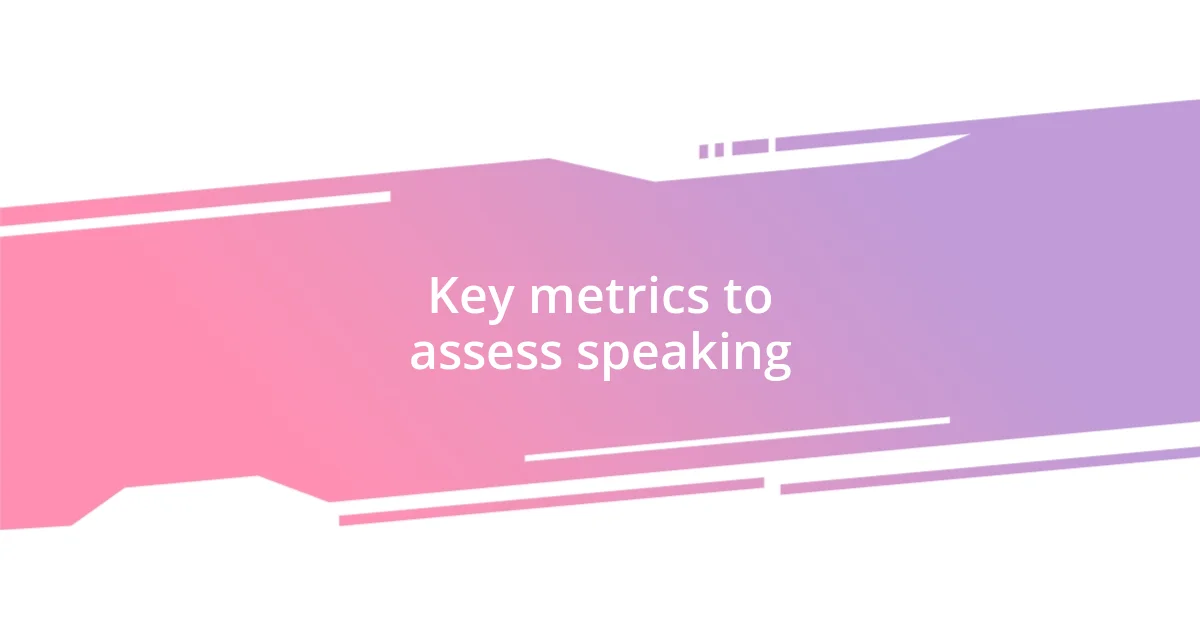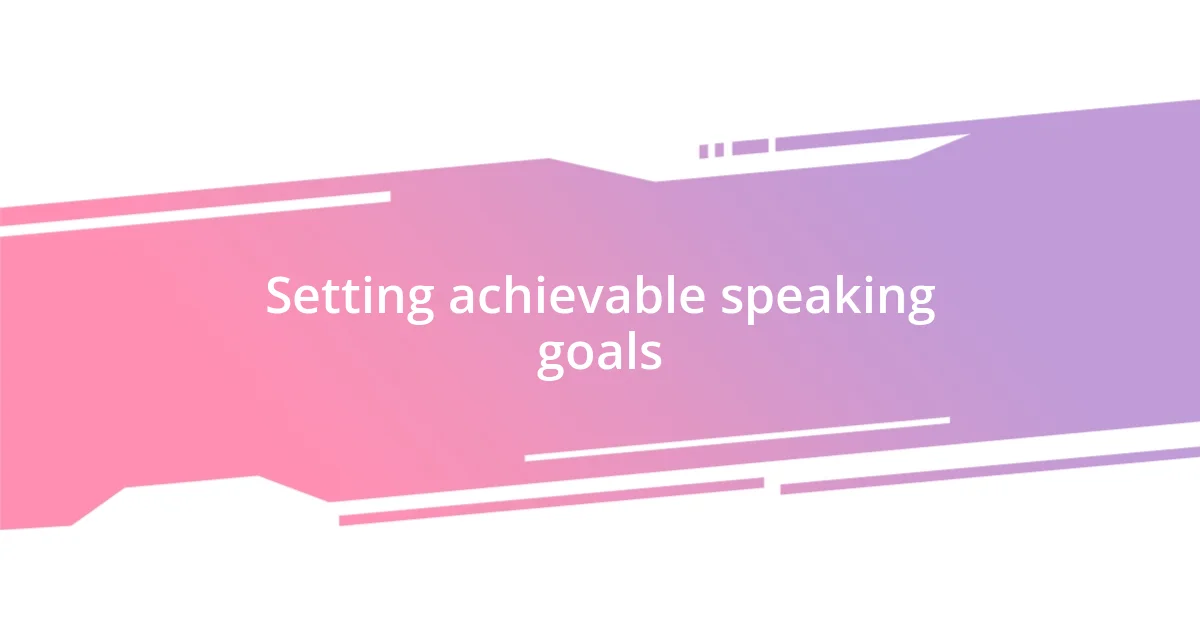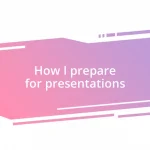Key takeaways:
- Authenticity and emotional connection with the audience are crucial for measuring speaking success, often more important than perfection.
- Effective feedback gathering through anonymous surveys, conversational check-ins, and live polls enhances speaker growth and audience engagement.
- Setting achievable goals and practicing reflection, such as keeping a journal and recording speeches, supports continuous improvement in speaking skills.

Understanding speaking success
Speaking success isn’t just about being polished or charismatic; it’s about connecting with your audience. I remember giving a presentation where, despite my shaky hands and racing heart, I was able to engage my listeners through genuine storytelling. It made me realize that authenticity often outweighs perfection in effective communication.
When I reflect on my own speaking experiences, I find that success can also be measured by the emotional response of the audience. After a talk, someone once approached me with tears in their eyes, saying my words resonated deeply with their struggle. Isn’t that a powerful indicator of success? It’s not just about delivering a message; it’s about leaving a meaningful impact.
In my journey, I’ve learned that feedback plays a crucial role in understanding speaking success. I often solicit input from trusted friends after a speech. Their insights help me recognize what worked and what could be better. This process of reflection not only sharpens my skills but also deepens my connection with my audience over time. What about you? How do you gauge your speaking success?

Key metrics to assess speaking
To effectively gauge speaking success, it’s essential to consider specific metrics that reflect audience engagement and personal growth. I often rely on audience feedback forms, which can highlight aspects that resonated well and areas needing improvement. Once, during a workshop, I was pleasantly surprised to see a high percentage of attendees rating my delivery style as “engaging.” This immediate feedback bolstered my confidence and reinforced the value of seeking direct responses.
Here are some key metrics I focus on:
– Audience Participation: Observing how actively the audience engages through questions or discussions.
– Emotional Reactions: Noting laughter, tears, or other visible emotions during the talk.
– Post-Speech Feedback: Collecting personal testimonials or comments to understand the lasting impact.
– Follow-Up Questions: The number and depth of inquiries I receive after the talk can signify the level of interest generated.
– Content Retention: Evaluating how much information the audience recalls in follow-up conversations.
Measuring these elements not only helps in assessing my current speaking effectiveness but also paves the way for continuous improvement.

Gathering audience feedback effectively
Gathering audience feedback is one of the most rewarding aspects of my speaking journey. I find that creating an inviting atmosphere for feedback encourages honesty. For instance, after a recent presentation, I handed out brief anonymous surveys, and the answers were eye-opening. One attendee shared that my use of humor made a complex topic more relatable, while another suggested I slow my pace. This variety in feedback made me appreciate the diverse perspectives in my audience.
I’ve also experimented with informal feedback methods—like conversational check-ins. After a workshop, I often mingle and ask attendees for their thoughts over coffee or snacks. One time, a participant shared how my insights sparked a new idea for their project. The joy of hearing someone’s excitement about applying what I shared is priceless. It transforms abstract feedback into a tangible connection, deepening my understanding of whether I made the intended impact.
Finally, I recommend utilizing technology for effective feedback gathering. Simple tools like live polls during a presentation can provide instant reactions. I once used an app that allowed the audience to rate my talk in real-time, which was thrilling! Seeing the results display immediately not only engaged the listeners but also allowed me to pivot my delivery if necessary. The interaction was revitalizing and reinforced why feedback is essential for my growth as a speaker.
| Feedback Method | Pros |
|---|---|
| Anonymous Surveys | Encourages honesty, captures diverse opinions |
| Conversational Check-Ins | Creates personal connections, allows for in-depth insights |
| Live Polls | Instant feedback, engaging for the audience |

Self-reflection techniques for speakers
Self-reflection techniques have become a cornerstone of my growth as a speaker. I often take a moment after each talk to simply sit in quiet contemplation. During these moments, I ask myself, “What felt right?” or “What could I have done differently?” This practice helps me pinpoint not just the successes but also moments that could use more finesse, allowing me to approach my next speaking engagement with a clearer mind.
A technique I find invaluable is keeping a reflective journal dedicated solely to my speaking experiences. After each event, I jot down immediate thoughts and feelings—how I felt on stage, the audience dynamics, and even my own nervous ticks. Looking back at these entries sometimes brings a smile; I remember the thrill of connecting with the audience or the nervousness before stepping up to speak. These reflections not only capture my emotional journey but serve as a roadmap for my future presentations.
I also believe in the power of video recordings. Watching myself in action can be a reality check, and I often ask, “What does my body language say?” It’s remarkable how I can catch nuances I missed in the heat of the moment. For instance, I was shocked to see how I subconsciously fidgeted during a pivotal point in my last presentation, which I hadn’t felt at the time. These insights inspire me to refine my delivery, and I encourage other speakers to embrace this tool as a part of their self-reflection arsenal. Wouldn’t it be amazing to see how others perceive you in ways you might overlook?

Analyzing presentation outcomes
When I analyze my presentation outcomes, I look beyond the sheer feedback numbers to understand the underlying trends. For example, during a recent seminar, I noticed that my energy level influenced engagement. Attendees responded enthusiastically when I was animated, yet their interest waned when I got too technical. This tells me that connecting with my audience emotionally can significantly enhance their experience.
Time is another factor I consider crucial in gauging success. I often reflect on how well I managed my allotted time. One time, I clocked myself at a 20-minute slot and, despite having valuable content, I rushed through the last few points, leaving my audience less informed than I’d hoped. I learned that pacing is as important as content delivery. How often have I found myself running out of time? It’s a common pitfall, and acknowledging it helps me plan better for future talks.
I also delve into post-presentation discussions with fellow speakers or mentors who attended. Their insights often reveal blind spots I hadn’t considered. Recently, a mentor pointed out that while my content was rich, it lacked variety in delivery. I hadn’t realized how the same tone could dull even the best discussions. This reminder pushes me to explore multiple ways of presenting ideas, helping me stay dynamic and engaging. Have you ever had someone challenge your perspective and later realized how essential that feedback was for your growth? Those interactions are golden opportunities for learning.

Setting achievable speaking goals
Setting achievable speaking goals is essential for making tangible progress in your speaking journey. For me, I find that breaking down my goals into smaller, manageable parts helps tremendously. Instead of aiming for perfection in every presentation, I focus on improving specific aspects, like my vocal variety or audience engagement techniques. This focus gives me a clear path forward, and I notice that small victories accumulate over time—they feel satisfying and motivate me for the next challenge.
I remember one particular event where I set a goal to incorporate more storytelling into my presentation. Initially, it felt daunting, but I committed to practicing just one new story each week. By the time the event arrived, I had a handful to choose from that resonated with me and my audience. Hearing their laughter and engagement was incredibly rewarding, and it reinforced my belief that setting goals, no matter how small, can lead to significant transformations. Have you ever set a simple goal only to find it opened a floodgate of creativity and confidence?
Another strategy I use involves setting measurable outcomes. For example, I decided to track the number of questions I received at the end of my talks as a way to gauge audience interest. At first, it was just a number, but over time, I came to see it as a reflection of my connection with the audience. When I hit ten questions in one session, I felt a rush of excitement—I realized that my content sparked curiosity and dialogue. Isn’t it fascinating how setting clear metrics can shift our perspective on success? It takes the pressure off perfection and invites a deeper engagement with our audience.

Continuous improvement strategies for speaking
When refining my speaking skills, I make a point to embrace a habit of regular practice. I remember struggling with my pacing during speeches. To address this, I began recording my rehearsals and playing them back. Listening to myself helps identify areas where my speech feels rushed or lacks emphasis. Have you ever cringed at your own voice? It can be uncomfortable but incredibly enlightening, allowing me to adjust my delivery before I face a live audience.
Another strategy I employ is seeking diverse speaking opportunities. Each event brings its own unique audience and environment, which challenges me to adapt. For instance, one time I presented at a local community center, and the energy was vastly different from the corporate settings I was used to. This experience forced me to be more relatable and engaging with a casual crowd. It taught me that versatility is crucial in speaking—how do you adjust your tone and approach depending on your audience?
Finally, I utilize feedback loops with trusted colleagues. After sharing my presentations with them, their critiques are invaluable. Recently, a peer pointed out that my visual aids could be more impactful. Instead of just adding text, I shifted to thought-provoking images that resonate emotionally. This adjustment transformed the way I connected with my audience, both visually and intellectually. Have you ever felt a presentation click because of just one piece of feedback? It’s moments like these that fuel my continuous improvement.














